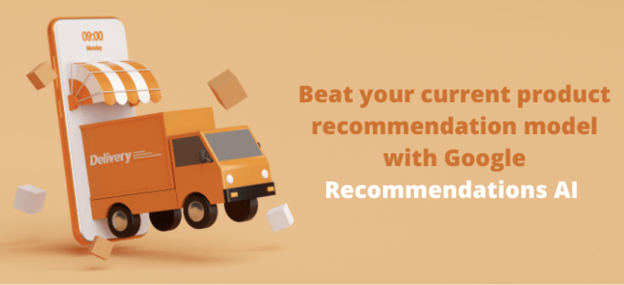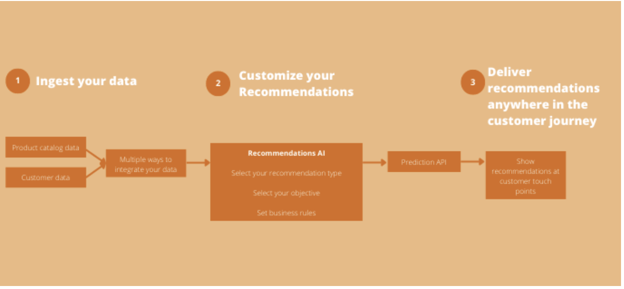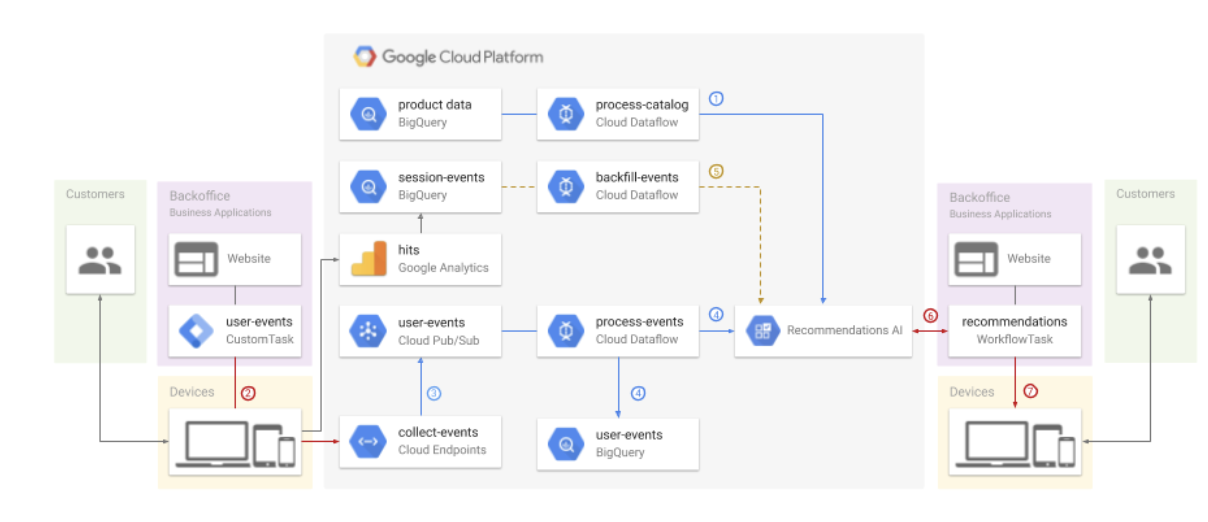Share this
Get Ahead with Google Recommendations AI
by Meliska Meintjes on Jul 26, 2022 4:17:01 PM

Your business success is highly dependent on your ability to deliver accurate recommendations to your website users and customers, whereafter you can build trust and increase revenue. Online shoppers receiving personalized recommendations are four times more likely to shop on an eCommerce site than those who don't.
That's because recommendations engines help to:
- Deliver highly personalized recommendations at a large scale
- Leverage the best algorithms
- Adapt to user behavior in real-time
- It is a fully managed service
How does Recommendation AI work?
Based on visitors' previous behavior or information you hold about them, product recommendation engines display products to them as suggested products.
As with the recommendations across many eCommerce stores, recommendation engines can also include suggestions for first-time customers, such as those under “often bought together” or “customers also bought.” As a result, basket size and average order value can increase.
Recommendation engines are not just used for eCommerce and sales but can also be used to recommend relevant content based on the behavior and demographics of users. Take Netflix as an example: it recommends new shows for you based on what you have already watched.
YouTube, Google Search, and Google Play use one of the largest and most sophisticated industrial recommendation systems. Google didn’t take long to make this knowledge and computing power available outside their offered products. Today I would like to highlight Google’s packaged AI product: Recommendations AI and how it can beat your current recommendations model.
Google Recommendations AI
Recommendations AI is a personalized recommendation system for products that are based on machine learning models developed by Google. It enables organizations to build recommendation systems without needing Machine Learning knowledge.
As with YouTube recommendations and tailored ads across its network, Google has used recommendation engines in its content for years. Google has invested heavily in machine learning and artificial intelligence, and website owners and developers can now harness the power of its technology to offer their customers more accurate recommendations.
Data from product catalogs and CRM systems is gathered and filtered using Google Cloud technology, which delivers proactive and timely recommendations based on your preferences.
Providing more information to ideal consumers when they desire it gives website owners and developers a competitive advantage, leading to higher customer satisfaction and higher revenues (as well as increased sales and better conversion rates).
How can you make it work for you
You can build a recommendation system from end to end using Recommendations AI.
State of the art Deep Learning ML models without experience related to ML or recommendation systems.
You can implement this in 3 steps:
- Ingest your data
- Customize your recommendations
- Deliver to channels

1. Ingest your data
Start ingesting the products from your catalog that you want to use. Of course, you will bring your customer data in as well. The architecture might look like this when the recommendations are pushed to the website:

For model deployment, Recommendation AI needs user event data. This data needs to be collected in real-time. You can do this using Google Tag Manager, a Javascript pixel, or directly from your backend.
You can also rely on historical user events. This way, you don’t need to wait long for the model to train. You can import historical data from Google Analytics, Big Query, or Google Cloud Storage.
2. Select what you want to achieve
Select recommendation type
- Recommended for you (ex. on the home page)
- Other items you may like (ex. on the product detail page)
- Frequently bought together (ex. in shopping cart view/ checkout start)
- Recently viewed (not a recommendation but valid on ex. home page)
Select objective
- Click-through rate (This is used to emphasize engagement / maximize the likelihood that the user interacts with the recommendation)
- Conversion rate (This is the default optimization objective for the "Frequently bought together")
- Revenue per session (This maximizes the likelihood that the user purchases the recommended item)
Set business rule
- Filter on articles that are out of stock
- Filter on duplicate items
- Filter by a custom tag
- Result diversification on/off
- Personalization on/off
3. Deliver to channels
You can deliver to any channel such as Web, Mobile web, Mobile apps, email, social media, etc.
Afterward, you need to test Recommendation AI. This is done to:
- Define success criteria for Recommendations AI
- Build pipeline for transferring product catalog data to Recommendations AI
- Build pipeline for transferring user-events data to recommendations AI in real-time via Pub/Sub and Dataflow
- Build pipeline for backfilling historic user events from BigQuery to Recommendations AI
- Customize Recommendations AI for delivering personalized content on a website channel
- Test Google Recommendations AI model for delivering personalized content on the Web, Mobile web, Mobile apps, email, social media, or any other channel of your choice
Conclusion
Recommendations AI is freely available and easily implementable to increase your value offer to your clients immediately. You can follow this step-by-step guide if you want to build a recommendation system with Recommendations AI and need more detail.
Crystalloids is experienced with numerous clients in designing and implementing the entire cycle using several technologies if you want to act quickly and don’t want to make the mistakes that others did, contact us.
ABOUT CRYSTALLOIDS
Crystalloids helps companies improve their customer experiences and build marketing technology. Founded in 2006 in the Netherlands, Crystalloids builds crystal-clear solutions that turn customer data into information and knowledge into wisdom. As a leading Google Cloud Partner, Crystalloids combines experience in software development, data science, and marketing, making them one of a kind IT company. Using the Agile approach, Crystalloids ensures that use cases show immediate value to their clients and make their job focus more on decision making and less on programming.
Share this
- February 2025 (2)
- January 2025 (3)
- December 2024 (1)
- November 2024 (5)
- October 2024 (2)
- September 2024 (1)
- August 2024 (1)
- July 2024 (4)
- June 2024 (2)
- May 2024 (1)
- April 2024 (4)
- March 2024 (2)
- February 2024 (2)
- January 2024 (4)
- December 2023 (1)
- November 2023 (4)
- October 2023 (4)
- September 2023 (4)
- June 2023 (2)
- May 2023 (2)
- April 2023 (1)
- March 2023 (1)
- January 2023 (4)
- December 2022 (3)
- November 2022 (5)
- October 2022 (3)
- July 2022 (1)
- May 2022 (2)
- April 2022 (2)
- March 2022 (5)
- February 2022 (3)
- January 2022 (5)
- December 2021 (5)
- November 2021 (4)
- October 2021 (2)
- September 2021 (2)
- August 2021 (3)
- July 2021 (4)
- May 2021 (2)
- April 2021 (2)
- February 2021 (2)
- January 2021 (1)
- December 2020 (1)
- October 2020 (2)
- September 2020 (1)
- August 2020 (2)
- July 2020 (2)
- June 2020 (1)
- March 2020 (2)
- February 2020 (1)
- January 2020 (1)
- December 2019 (1)
- November 2019 (3)
- October 2019 (2)
- September 2019 (3)
- August 2019 (2)
- July 2019 (3)
- June 2019 (5)
- May 2019 (2)
- April 2019 (4)
- March 2019 (2)
- February 2019 (2)
- January 2019 (4)
- December 2018 (2)
- November 2018 (1)
- October 2018 (1)
- September 2018 (2)
- August 2018 (3)
- July 2018 (3)
- May 2018 (2)
- April 2018 (4)
- March 2018 (5)
- February 2018 (2)
- January 2018 (3)
- November 2017 (2)
- October 2017 (2)


